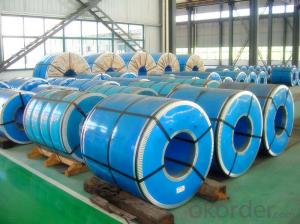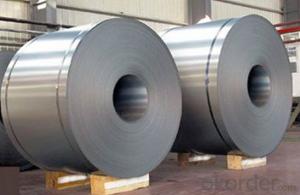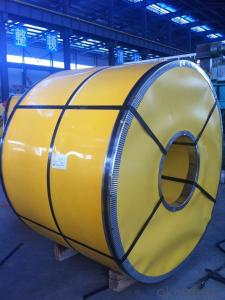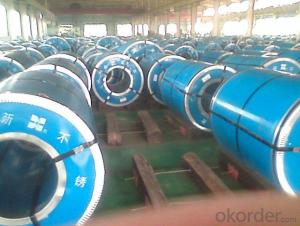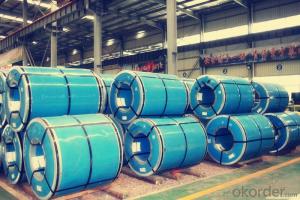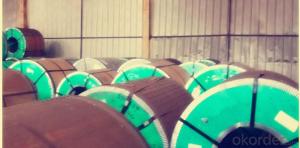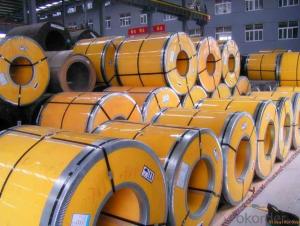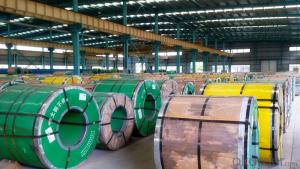Stainless Steel Coil/Sheet 304 NO.1 HRAP
- Loading Port:
- Ningbo
- Payment Terms:
- TT OR LC
- Min Order Qty:
- 100 m.t.
- Supply Capability:
- 20000 m.t./month
OKorder Service Pledge
Quality Product, Order Online Tracking, Timely Delivery
OKorder Financial Service
Credit Rating, Credit Services, Credit Purchasing
You Might Also Like
Chemical composition: | |||||||
C | Si | Mn | Cr | Ni | S | P | |
≤0.07 | ≤1.0 | ≤2.0 | 18.0~20.0 | 8.0~11.0 | ≤0.03 | ≤0.035 | |
mechanical properties: | |||||||
Tensile strength σb (MPa) | Conditions yield strength 0.2 sigma (MPa) | Elongation δ5 (%) | Section shrinkage (%) | Hardness | |||
520 | 205 | 40 | 60 | ≤1 | |||
- Q: Are stainless steel strips suitable for welding with other materials?
- Yes, stainless steel strips are suitable for welding with other materials. Stainless steel is known for its exceptional corrosion resistance and high strength, making it a popular choice for various applications. When it comes to welding, stainless steel strips can be welded with other materials such as carbon steel, aluminum, and nickel alloys. However, it is important to consider the differences in properties and composition between the materials being joined to ensure proper welding procedures are followed. Additionally, the choice of welding method and filler material may vary depending on the specific application and desired results. Overall, stainless steel strips can be successfully welded with other materials, but it is essential to consult with welding experts or refer to welding guidelines to ensure a strong and reliable joint.
- Q: Are stainless steel strips suitable for elevator cabins?
- Yes, stainless steel strips are suitable for elevator cabins. Stainless steel is a popular choice for elevator cabins due to its durability, strength, and aesthetic appeal. It is resistant to corrosion, scratches, and stains, making it ideal for high-traffic areas like elevator cabins. Additionally, stainless steel is easy to clean and maintain, ensuring a hygienic environment for passengers. Its sleek and modern appearance also adds a touch of elegance to the overall design of the elevator. Overall, stainless steel strips are a reliable and stylish choice for elevator cabins.
- Q: What are the different types of corrosion that can affect stainless steel strips?
- There are several types of corrosion that can affect stainless steel strips, including pitting corrosion, crevice corrosion, galvanic corrosion, stress corrosion cracking, and intergranular corrosion.
- Q: What are the different surface finishes for stainless steel strips?
- There are several different surface finishes available for stainless steel strips, each offering unique characteristics and appearances. Here are some of the most common surface finishes for stainless steel strips: 1. No.1 Finish: This is the most widely used and basic finish for stainless steel strips. It has a rough, dull appearance with visible grinding marks. No.1 finish is often used for applications where aesthetics are not a priority, such as industrial components or structural parts. 2. 2B Finish: This finish is characterized by a smooth, reflective surface with a moderate level of gloss. It is achieved through a cold-rolling process, followed by annealing and descaling. 2B finish is commonly used in applications where a smooth and even surface is desired, such as kitchen appliances, architecture, and automotive trim. 3. No.4 Finish: Also known as brushed or satin finish, this surface treatment creates a soft, linear grain pattern on the stainless steel strip. It is achieved through polishing the strip with abrasive belts or brushes. No.4 finish is commonly used in decorative applications, such as furniture, handrails, and signage. 4. BA Finish: BA stands for Bright Annealed, and this finish offers a highly reflective, mirror-like surface. It is achieved through annealing the stainless steel strip in a controlled atmosphere, followed by a final polishing process. BA finish is often used for decorative purposes, such as architectural features, jewelry, and luxury consumer goods. 5. Electropolished Finish: This is a specialized surface treatment that involves immersing the stainless steel strip in an electrolyte solution and applying an electric current. Electropolishing removes a thin layer of material and leaves a smooth, shiny surface with enhanced corrosion resistance. This finish is commonly used in applications where hygiene and cleanability are essential, such as pharmaceutical equipment, food processing, and medical devices. These are just a few examples of the many surface finishes available for stainless steel strips. The choice of finish depends on the specific requirements of the application, including aesthetics, functionality, and corrosion resistance.
- Q: Are stainless steel strips suitable for food-grade applications?
- Yes, stainless steel strips are suitable for food-grade applications. Stainless steel is a popular choice for food processing and packaging due to its excellent corrosion resistance, durability, and hygienic properties. It does not react with food or alter its taste, making it a safe and reliable material for use in food-grade applications. Stainless steel strips can be used for various purposes in the food industry, such as manufacturing equipment, utensils, containers, and storage tanks. Additionally, stainless steel is easy to clean and maintain, making it a preferred choice for maintaining high sanitary standards in food processing environments.
- Q: How do stainless steel strips perform in abrasive environments?
- Stainless steel strips perform exceptionally well in abrasive environments due to their high resistance to corrosion, rust, and wear. The inherent properties of stainless steel, such as its chromium content, form a protective oxide layer that shields the material from abrasive elements. This enables stainless steel strips to withstand harsh conditions, maintain their strength, and retain their aesthetic appeal even in abrasive environments.
- Q: Are stainless steel strips resistant to chloride stress corrosion cracking?
- Yes, stainless steel strips are generally resistant to chloride stress corrosion cracking. Stainless steel is known for its excellent corrosion resistance properties, and this includes resistance to chloride stress corrosion cracking. This is due to the high levels of chromium present in stainless steel, which forms a protective oxide layer on the surface of the material, preventing the penetration of chloride ions and subsequent corrosion. However, it is important to note that the resistance to chloride stress corrosion cracking can vary depending on the specific type and grade of stainless steel used, as well as the specific environmental conditions in which the material is exposed. Therefore, it is always recommended to consult the manufacturer's specifications and guidelines to ensure the appropriate grade of stainless steel is selected for the intended application.
- Q: What are the limitations of using 111 stainless steel strips?
- There are several limitations associated with using 111 stainless steel strips: 1. Corrosion Resistance: While stainless steel is generally known for its corrosion resistance, 111 stainless steel strips may not have the same level of resistance as other grades. This can make them more susceptible to corrosion in certain environments, such as those with high levels of chloride or sulfur. 2. Strength and Hardness: Compared to other stainless steel grades, 111 stainless steel strips may have lower strength and hardness properties. This can limit their suitability for applications that require high tensile strength or resistance to wear and abrasion. 3. Weldability: Welding 111 stainless steel strips can be challenging due to their higher carbon content. This can result in the formation of carbides during the welding process, leading to reduced weldability and potential brittleness in the heat-affected zone. 4. Magnetic Properties: Unlike some other stainless steel grades, 111 stainless steel strips are generally magnetic. This can limit their use in certain applications where non-magnetic properties are required, such as in electronic devices or sensitive equipment. 5. Availability and Cost: 111 stainless steel strips may be less readily available in the market compared to more common grades. This can make them harder to source and potentially more expensive. 6. Temperature Limitations: 111 stainless steel strips may have limitations when exposed to high temperatures. They may exhibit reduced strength and increased susceptibility to oxidation or scaling, which can restrict their use in high-temperature applications. It is important to consider these limitations when selecting stainless steel strips for specific applications, as they can impact the performance, durability, and cost-effectiveness of the material.
- Q: What are the different types of surface textures for stainless steel strips?
- Stainless steel strips offer a range of surface textures, each with its own distinct qualities and visual appeal. Let's explore a few common options: 1. No.1 Finish: The most basic and widely used texture, it has a rough, dull appearance. It is created by hot rolling and is commonly used in industrial settings where appearance is not a priority. 2. No.2B Finish: Achieved through hot and cold rolling with annealing, it has a smooth, reflective look with a slightly less shiny finish than No.1. No.2B is popular in kitchen appliances, architectural components, and decorative applications. 3. No.4 Finish: Also called satin or brushed finish, it involves mechanical polishing with abrasives. This creates a consistent, linear appearance with low reflectivity. No.4 is favored in architectural and interior design for decorative purposes. 4. BA (Bright Annealed) Finish: Obtained through bright annealing, it enhances corrosion resistance and offers a highly reflective, mirror-like appearance. BA finish is ideal for applications where reflectivity and aesthetics are important, like automotive trim and decorative items. 5. No.8/Mirror Finish: The highest quality and most reflective texture, it undergoes a multi-step process of grinding, polishing, and buffing. This results in a flawless, mirror-like look. No.8 is commonly used in luxury architectural projects, high-end decorative applications, and luxury goods. These examples represent just a few of the surface textures available for stainless steel strips. The choice depends on specific requirements, including aesthetics, functionality, and durability.
- Q: Are stainless steel strips resistant to chemicals?
- Yes, stainless steel strips are generally resistant to chemicals. They have a high level of corrosion resistance, making them suitable for various chemical environments. However, the degree of resistance may vary depending on the specific type and grade of stainless steel used.
Send your message to us
Stainless Steel Coil/Sheet 304 NO.1 HRAP
- Loading Port:
- Ningbo
- Payment Terms:
- TT OR LC
- Min Order Qty:
- 100 m.t.
- Supply Capability:
- 20000 m.t./month
OKorder Service Pledge
Quality Product, Order Online Tracking, Timely Delivery
OKorder Financial Service
Credit Rating, Credit Services, Credit Purchasing
Similar products
Hot products
Hot Searches
Related keywords
